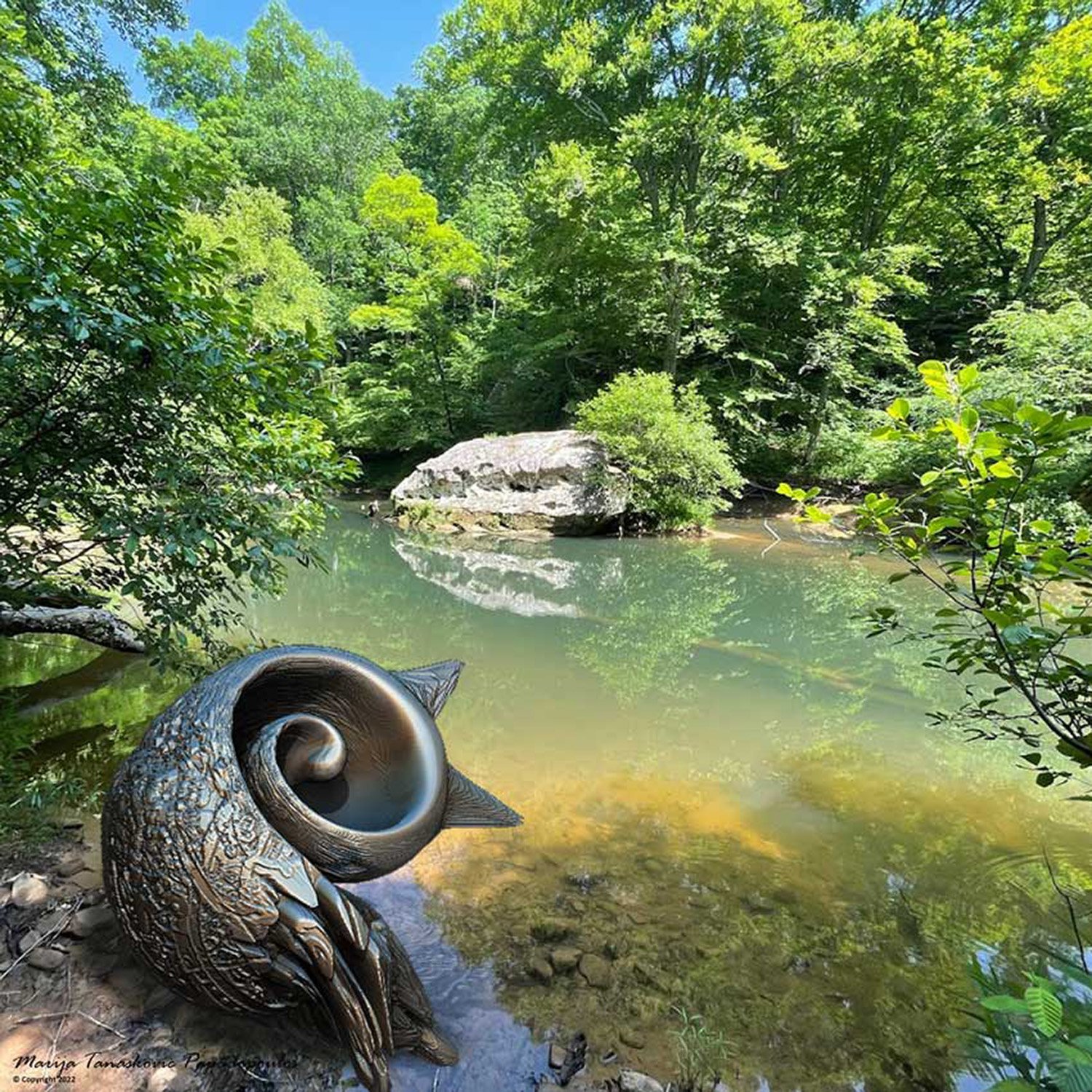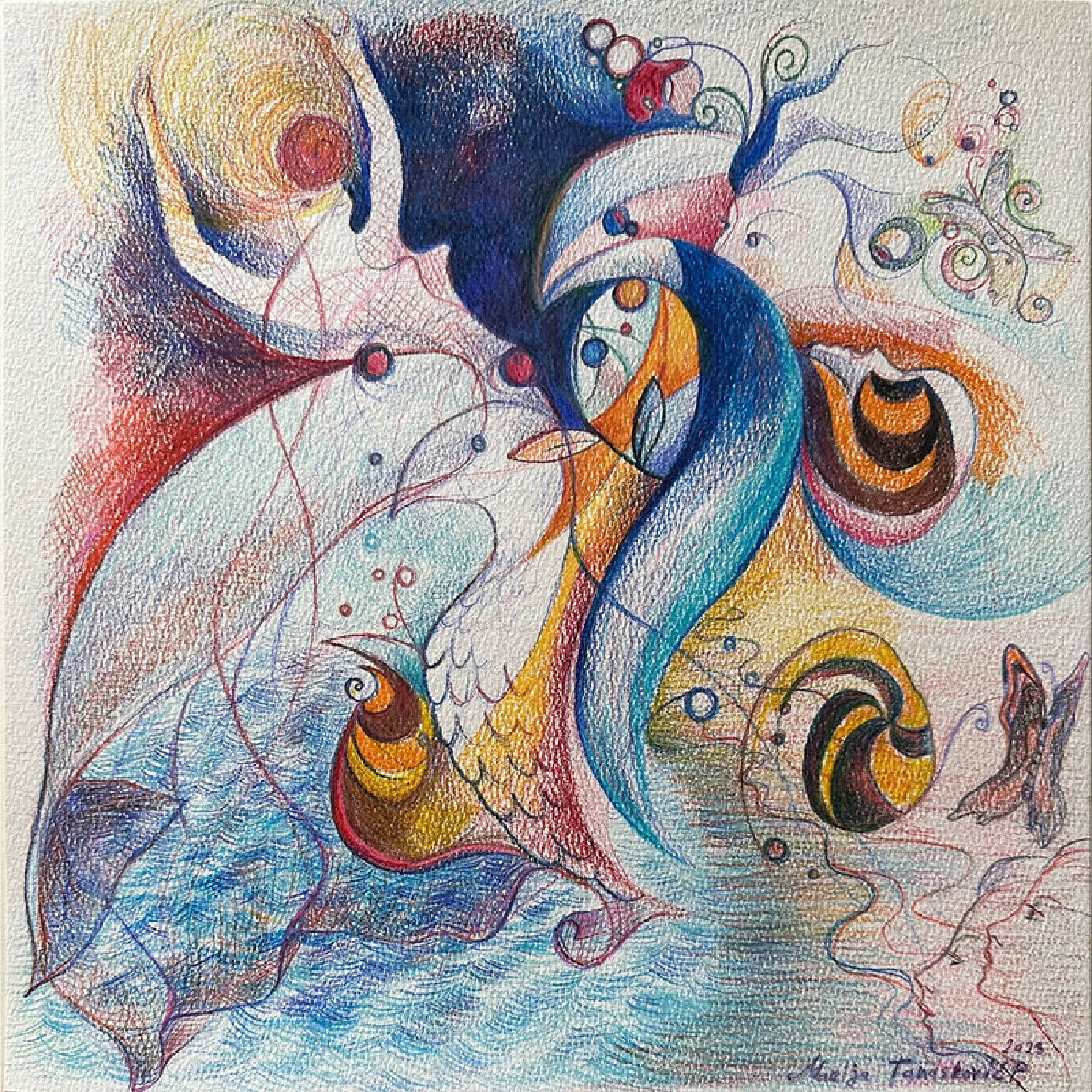Marija Tanaskovic Papadopoulos
The Harmonious Resonance of Spirit and Form: The Art of Marija Tanaskovic Papadopoulos
Marija Tanaskovic Papadopoulos’s work is a triumph of visual transcendence, a compelling testament to the power of art to channel spiritual energy and beauty into the world. Her art is rooted in a profound understanding of both traditional and digital mediums, creating a fusion that is as technically adept as it is spiritually potent. This synthesis of past and present—oil on canvas alongside digital sculpture—is the hallmark of her style, which is immediately recognizable for its fluid lines, vibrant colors, and intricate, symbolic compositions. Her artworks convey an energetic vibrancy that seems to pulse from within, inviting viewers to move beyond mere visual engagement and into a deeper, almost meditative state.
What strikes the viewer first about Marija's art is her dynamic use of color and line. Her works are filled with swirling, undulating forms that seem to defy the boundaries of their medium. Her palette, a radiant symphony of colors, often recalls the luminous hues of stained glass, yet her approach is contemporary, grounding her works firmly in the present. In her paintings and drawings, the lines do not simply outline forms; they dance, twist, and shimmer, acting as conduits for energy. Marija has a clear sensitivity to the rhythm of lines, using them to evoke movement and emotion in a way that feels both abstract and narratively rich. Her lines are reminiscent of Wassily Kandinsky’s theory of color and form as expressive agents of the spiritual, yet she moves beyond Kandinsky in her embrace of both natural and metaphysical imagery.
In “Seed of Will,” there is an organic quality that recalls the interweaving of plants and the flowing nature of water. The work hints at the cyclical, almost cosmic nature of existence, yet it is imbued with a personal vision that is unmistakably Marija Tanaskovic Papadopoulos own. Her forms resonate with the viewer on an intuitive level, embodying a sense of growth, resilience, and transformation. Similarly, “Inside the Nature of Mistreated Nature” draws on environmental themes, but rather than presenting a bleak portrayal of decay, she fills the work with layers of hope and healing. There is an implicit narrative woven into the colors and forms, suggesting that nature's resilience and beauty endure despite human interference. This subtle interplay of symbolic resonance is where Marija Tanaskovic Papadopoulos’s genius shines.
Marija Tanaskovic Papadopoulos’s sculptures bring an added dimension to her oeuvre, translating the ethereal qualities of her paintings into tactile forms. Her works in Z-Brush, an advanced digital sculpting program, exhibit a fluidity that mirrors her drawn lines. The sculptures appear to be caught in motion, a frozen dance where every curve and angle is meticulously crafted to resonate with the surrounding space. This quality of suspended motion can be seen in works like “Phoenix,” where the mythical creature is not merely depicted but seems to be in the act of rising, embodying rebirth and strength. Her ability to convey a sense of movement and vitality through both virtual and physical forms aligns her with artists like Umberto Boccioni, who sought to express the dynamism of modern life in sculpture. However, unlike the raw energy of Boccioni’s futurism, Marija’s work has a spiritual undertone that resonates with the quietude of Rodin’s contemplative figures.
One of the most captivating aspects of Marija Tanaskovic Papadopoulos’s art is her dual mastery of light and shadow. In works like “Heaven’s Gate,” her nuanced handling of light becomes a narrative device, illuminating certain forms while casting others into shadow. This manipulation of light creates a visual rhythm that guides the viewer’s eye through the composition, evoking an almost otherworldly atmosphere. It is as if she is painting not just with pigment but with luminescence itself. The luminous quality of her colors, coupled with the ethereal forms she conjures, creates an experience that is both visceral and mystical. This approach to light, in its emphasis on spiritual transcendence, aligns her with the Symbolist movement, echoing artists like Odilon Redon, who also sought to render the unseen.
In “Air of the Holy Trinity,” her ability to infuse abstract forms with spiritual significance is on full display. The composition evokes a sense of sacred geometry, using curvilinear forms to represent the interconnectedness of the divine. Yet, Marija does not confine herself to overt religious symbolism; instead, she imbues universal shapes with spiritual meaning, allowing viewers of all backgrounds to find their own interpretations. This universality, coupled with her highly personal aesthetic language, makes her work both accessible and profound. Like Hilma af Klint, whose works were deeply spiritual yet remained grounded in abstraction, Marija Tanaskovic Papadopoulos communicates complex, metaphysical ideas through the language of color and form.
Her digital works, particularly those created in Z-Brush, extend her artistic philosophy into the virtual realm, blurring the boundaries between reality and digital imagination. These works are not merely digital imitations of sculpture but exist as fully realized entities in their own right, expanding the possibilities of what sculpture can mean in the modern age. Her piece, “Sophisticated Wings,” exemplifies this: the sculpture appears almost fluid, as if captured in a moment of transformation. The digital medium allows her to explore forms that would be challenging in physical media, enabling her to push the limits of her creativity. In this way, she is comparable to modern pioneers like Daniel Arsham, who merge physical and digital realms to question the nature of art and perception.
In her landscapes and nature-inspired works, Marija continues to demonstrate a reverence for the natural world, yet her style is never static or confined by realism. “Droplets of Divine,” for instance, is a work that exists in the liminal space between representation and abstraction. Here, she captures the essence of water—not merely as a physical substance but as a symbol of life, purity, and the sublime. This work, and others like it, seem to be infused with a sense of ecological consciousness, urging viewers to reconnect with the environment in a manner that is both reverent and urgent.
As an artist, Marija Tanaskovic Papadopoulos also utilizes photography, a medium she elevates from mere documentation to an artistic experience. Her photograph, “Rapture Dream,” captures a moment that feels at once intimate and universal, suggesting an unseen narrative beyond the frame. Her photographs are deeply atmospheric, often depicting landscapes bathed in ethereal light or shadow. The interplay of light and landscape in her photography resonates with the same mystical quality found in her paintings, imbuing her images with a sense of timelessness.
Marija Tanaskovic Papadopoulos stands as a remarkable artist whose work defies easy categorization. Her ability to bridge traditional and digital media is matched only by her deep philosophical approach to art as a medium of energy and symbolism. Her art moves beyond mere aesthetics, serving as a conduit for beauty, harmony, and spiritual awakening. Marija Tanaskovic Papadopoulos’s work is a testament to the power of art to touch the unseen realms of human consciousness. Like the masters before her, she has an innate ability to transform paint, digital pixels, and sculpted forms into symbols that resonate on a universal level. Her artworks serve as reminders of the beauty that exists in both the physical and metaphysical worlds, urging viewers to see beyond the visible and connect with the underlying energy of life itself.
Marija Tanaskovic Papadopoulos’s art is a journey into a world where symbols become vessels of energy and color becomes a language of the soul. Through her mastery of line, form, and color, she crafts visual experiences that invite viewers to participate in an ongoing dialogue between matter and spirit. Her work is, in every sense, an exploration of harmony—the harmony of colors, the balance of forms, and the rhythmic flow of lines that bring each piece to life. She captures, in her words, the essence of beauty as a source of harmony, creating works that are not only visually captivating but deeply transformative. Marija Tanaskovic Papadopoulos’s art is indeed a gift, a reminder of the boundless potential of creativity to inspire, heal, and elevate the human spirit.
Droplets of Divine, 2021, Digital Graphic: Z-Brush and Photoshop, 101.6 X 101.6 cm
Air of Holy Trinity, 2021, Digital Graphic: Photography and Photoshop, 76.2 x 101.6 cm
Seed of Will, 2022, Digital Graphic: Photography and Z-Brush, 101.6 X 101.6 cm
Art Knight, 2022, Digital Graphic: Photography and Z-Brush, 76.2 x 101.6 cm
Phoenix, 2002, Dry Pastel on Paper, 43.8 x 33.02 cm
Heaven’s Gate, 2012, Dry Pastel on Paper, 45.72 x 60.96 cm
Inside the Nature of a Mistreated Nature, 2024, Colored Pencils on Paper, 22.86 x 33.06 cm
Sophisticated Wings, 2023, Colored Pencils on Paper, 22.86 x 33.06 cm
Thinking of Herself Painting, 2015, Oil on Canvas, 60.96 x 121.92 cm
Rapture Dream, 2023, Colored Pencils on Paper, 22.86 X 22.86 cm












